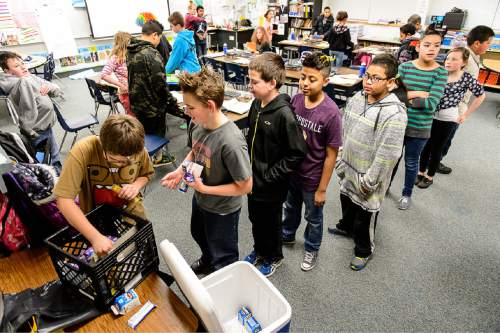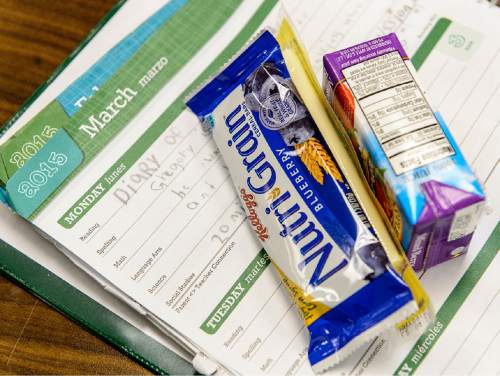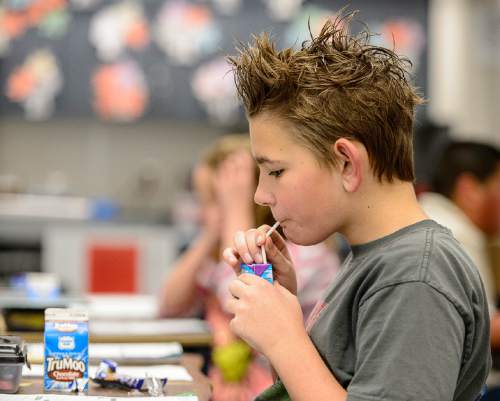This is an archived article that was published on sltrib.com in 2015, and information in the article may be outdated. It is provided only for personal research purposes and may not be reprinted.
Midvale • Shortly after 8:50 a.m. on Tuesday, students started trickling into Michele Brees' fifth-grade classroom at Copperview Elementary.
They hung up their wet coats and lined up to grab a cereal bar, string cheese and juice out of a blue cooler placed by the door.
Copperview student Kallie Leyba, who had tied balloon animals into her hair as part of a school-wide celebration of Dr. Seuss, said the breakfast was good. But she preferred the whole wheat pancakes the school serves at least once every two weeks.
"It gives me more energy to work," she said.
Most schools serve breakfast before classes begin. But Copperview is part of a growing trend to shift morning meals into the school day to boost participation and help children focus more on their studies and less on their growling stomachs.
The school made the switch last fall with the help of grant money from the State Office of Education. Now, teachers and school administrators say, students are more engaged and better-fed in the morning hours.
"They already have enough to worry about," Brees said. "They shouldn't have to worry about if they're going to have food or not."
In January, the Southern Education Foundation analyzed national data and found that low-income students make up the majority of public schoolchildren in the United States. In Utah, 59 percent of Utah students qualify for free or reduced-price school meals, which denotes low family income.
But traditional school breakfast programs aimed at serving low-income families are notorious for poor participation. Students either arrive too late to visit the cafeteria before class or choose to forego a meal in order to socialize with friends.
That leads to students who are lethargic and distracted, Brees said, which costs more in effective classroom time than the few minutes Copperview students spend eating breakfast in class.
"With this, everybody is focused," she said. "As soon as we start reading, everyone is ready to go."
On Tuesday, the Washington, D.C.-based advocacy organization No Kid Hungry released a study that promoted in-class breakfasts as a solution to child hunger.
Based on a national survey of educators, the study found 76 percent of teachers reported that their students regularly struggle with hunger, contributing to behavioral problems, poor academic performance and an inability to concentrate.
"I know how much better I feel when I have breakfast," Copperview Principal Chanci Loran said. "If they skip dinner as well, it's all the more important to start the day with breakfast."
In Granite School District, three schools currently run an in-class breakfast program and district food service director Rich Prall said the plan is to expand to seven or eight schools this spring.
He said there was initial skepticism among school faculty members who were worried about the distraction of food in class. But those same teachers are now "ambassadors" to their district peers, touting the academic benefits of an early-morning meal.
"If you want to get kids learning," he said, "breakfast is the meal that will do it."
Unlike before-school breakfast programs, which almost exclusively target low-income students, in-class breakfasts are offered for free to all children.
That means more individual meals are served, but Prall said it doesn't necessarily translate into higher costs for a school.
Meals for low-income students are reimbursed by the federal government, Prall said, so higher student participation correlates with a larger budget, particularly at Title 1 schools with high numbers of low-income families.
"It gets less and less effective as the economics of the community improve," Prall said. "It's not something that's right for all schools. But for Title 1 schools especially, it can really help those students start their day."
Sebasthian Varas, nutrition services director for Canyons School District, said breakfast participation at Copperview climbed from roughly 130 students to 480 students after the in-class program began.
There was an initial cost to purchase equipment and make logistical preparations, Varas said, but the program is now sustainable due to the increased participation and the reimbursements that come with it.
"We are able to break even and make a little profit," he said.
Loran said her teachers try to minimize the classroom disruption as much as possible by serving breakfast while they take attendance and morning announcements are broadcast.
Almost 90 percent of the students at Copperview qualify for free or reduced-price meals, Loran said. And between breakfast, lunch and after-school dinner programs, many students receive the bulk of their daily nutrition on school grounds.
She said the in-class breakfast program is a relatively simple solution to a large problem, helping to ensure that students from a variety of backgrounds are getting the nutrition they need.
"We're kind of leveling the playing field," she said. "We're giving them what most kids get" at home.













